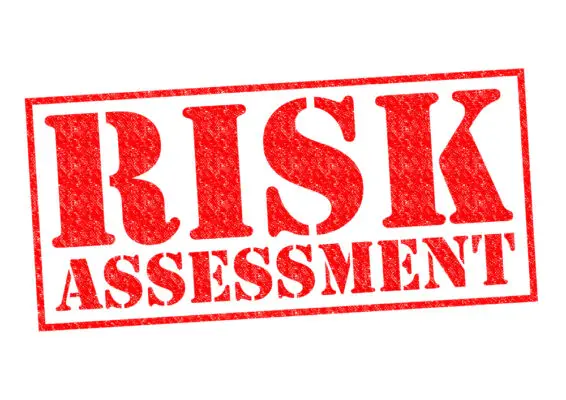Risk assessment in construction aims to identify potential hazards, evaluate their likelihood and consequences, plan and implement mitigation measures, ensure the safety of workers and the public, and minimize financial losses and project delays.
It systematically assesses risks associated with various construction activities, materials, equipment, and environmental factors.
Construction professionals can ensure the safety and success of their projects by conducting a thorough risk assessment to identify potential hazards that may endanger the health and well-being of workers.
This objective and detail-oriented approach allows for informed decision-making regarding risk prevention or reduction strategies, through careful evaluation of both the probability and severity of risks, effective measures can be implemented to mitigate these risks.
Ensuring a secure work environment for all parties involved is paramount in the construction industry. The process of risk assessment plays a critical role in achieving this goal.
Ensuring safety measures are prioritized and thoroughly examining all potential scenarios significantly reduces the likelihood of unexpected incidents causing financial setbacks and project delays.

Identify Potential Hazards
Identifying potential hazards is a crucial step in the risk assessment process within the construction industry. It allows for proactive measures to be implemented to mitigate any potential risks and ensure the safety of workers and stakeholders.
Potential hazard identification involves identifying all possible sources of harm or danger within a construction site or project.
This can include anything from hazardous materials, such as asbestos or lead-based paint, to unsafe working conditions, like inadequate scaffolding or faulty electrical systems.
Risk identification goes hand in hand with potential hazard identification. It involves assessing the likelihood and severity of each identified hazard occurring.
Construction professionals can make informed decisions about necessary precautions and control measures to minimize accidents, injuries, and property damage on construction sites by carefully examining all potential hazards and associated risks.
Evaluate the Likelihood and Consequences
Evaluating likelihood and consequences in risk assessment in construction. It focuses on three key points:
- Determining the probability of occurrence: When conducting a risk assessment, it is important to determine the probability of each identified hazard occurring, considering historical data, expert opinions, and any relevant factors.
- Assessing the potential impact on safety: It is crucial to assess the potential impact that each hazard could have on safety measures and precautions at the construction site.
- Assessing the potential impact on finances: Lastly, evaluating the potential financial implications of each hazard is essential to ensure that appropriate measures are taken to mitigate risks effectively.
Determining Probability of Occurrence
To gauge the likelihood of an event happening in construction projects, determining the probability of occurrence is a crucial step. This involves quantifying risk likelihood by considering various factors that may contribute to the occurrence or prevention of an event.
Risk mitigation strategies are vital in this process as they help identify and evaluate potential risks and their respective probabilities.
When determining the probability of occurrence, construction professionals rely on several indicators, such as:
- Historical data from similar projects.
- Expert opinions.
- Statistical analysis.
- Industry standards.
Additionally, site-specific conditions and project-specific variables are considered to ensure accuracy in assessing the likelihood of an event happening.
Construction stakeholders can make well-informed decisions about risk management and implement effective strategies to minimize potential negative impacts by utilizing these methods and considering all relevant factors.
Assessing Potential Impact on Safety and Finances
Assessing the potential impact on safety and finances involves evaluating the possible consequences that may arise in terms of both human well-being and financial resources.
It is necessary to analyze the cost-benefit of implementing safety measures in construction projects to ensure regulatory compliance. This process requires a detailed assessment of the risks involved, including identifying potential hazards and evaluating their likelihood of occurrence.
When assessing the potential impact on safety, it is important to consider the immediate consequences and any long-term effects that may arise due to accidents or incidents.
This includes considering factors such as injury severity, loss of life, and damage to property or equipment. By analyzing these potential impacts, construction companies can determine appropriate measures to mitigate risks and protect workers’ well-being.
Furthermore, assessing the potential impact on finances involves evaluating direct costs associated with accidents or incidents, such as medical expenses and property damage repairs, and indirect costs, like legal fees, insurance premiums, and lost productivity.
Construction companies can make informed decisions about risk management strategies by analyzing financial implications thoroughly.
A comprehensive evaluation of various factors, such as regulatory compliance and cost-benefit analysis, must be conducted to determine the potential impact on safety and finances.

Plan and Implement Mitigation Measures
When planning and implementing mitigation measures in construction, it is crucial to prioritize identifying and assessing potential hazards to minimize risks effectively.
This involves employing cost-effective strategies within a comprehensive risk management framework. To evoke an emotional response, consider the following:
Sub-list 1:
- Ensuring worker safety: Implementing safety protocols and providing appropriate personal protective equipment can instil a sense of security among workers, reducing anxiety and promoting productivity.
- Protecting public well-being: By addressing potential hazards such as structural weaknesses or environmental contamination, construction companies demonstrate their commitment to safeguarding the community’s welfare.
Sub-list 2:
- Preserving financial stability: Mitigating risks can help avoid costly accidents, delays, or legal disputes that could strain resources and jeopardize project completion.
- Enhancing reputation: Adopting thorough risk assessment practices showcases a company’s commitment to professionalism, reliability, and ethical business conduct.
Construction firms can effectively navigate challenges and establish stakeholder trust by using relevant keywords to discuss plan implementation and mitigation measures.
Ensure the Safety of Workers and the Public
Ensuring the safety and well-being of workers and the public is paramount in the construction industry, instilling a sense of security and trust while promoting productivity and community welfare.
To achieve this, it is essential to have comprehensive worker training programs focusing on safety protocols and best practices. These programs should cover topics such as hazard identification, proper use of personal protective equipment (PPE), emergency response procedures, and safe work techniques.
Additionally, strict adherence to safety regulations set by governing bodies is crucial. This includes complying with standards for fall protection systems, electrical safety, scaffolding requirements, and more.
Construction companies can reduce workplace accidents and injuries, safeguard their workers’ physical health, and uphold a favourable reputation in the community by implementing these measures.
| Worker Training | Safety Regulations |
|---|---|
| Hazard identification | Fall protection systems |
| Proper use of PPE | Electrical safety |
| Emergency response | Scaffolding requirements |
Table 1: Key Components of Worker Training Programs and Safety Regulations in the Construction Industry
Minimize Financial Losses and Project Delays
A systematic approach incorporating effective project management techniques and thorough cost analysis is essential to mitigate the financial losses and project delays commonly encountered in the construction industry.
Project cost management is crucial in minimizing financial losses by ensuring that projects are completed within budgetary constraints.
This involves accurately estimating costs, monitoring expenditures, and implementing cost control measures to prevent overspending.
Additionally, contingency planning is imperative to minimize project delays. Construction projects are inherently complex and subject to uncertainties such as weather conditions, material shortages, or unforeseen events.
Construction companies can effectively manage these challenges and maintain project timelines by developing contingency plans for potential risks and disruptions.
Integrating cost management and contingency planning is crucial for construction projects to avoid financial losses and delays.
Frequently Asked Questions
What are the legal requirements for conducting a risk assessment in the construction industry?
Legal obligations in the construction industry require conducting a risk assessment.
The risk assessment process involves identifying hazards, evaluating risks, implementing control measures, and reviewing the effectiveness of these measures to ensure worker safety and compliance with regulations.
How can technology be used to improve risk assessment processes in construction projects?
Incorporating technology in construction projects can improve risk assessment processes through digital tools and software.
These technologies enable more efficient data collection, analysis, and visualization, enhancing the accuracy and effectiveness of risk assessments.
What is the role of a project manager in overseeing the implementation of mitigation measures?
The project manager plays a crucial role in overseeing the implementation of mitigation measures.
Their responsibilities include ensuring that mitigation measures are effectively implemented and monitored to minimize risks and ensure the successful completion of construction projects.
Are any specific training or certifications required for individuals responsible for conducting risk assessments in construction?
Individuals responsible for conducting risk assessments in construction should have specific training and certification requirements.
These qualifications ensure they have the knowledge and skills to assess and mitigate risks in construction projects accurately.
How often should a risk assessment be reviewed and updated throughout the duration of a construction project?
The review frequency of a risk assessment in construction is crucial due to the importance of identifying and addressing new risks that may arise during the duration of a project. Regular updates ensure ongoing effectiveness and mitigation of potential hazards.

Conclusion
Risk assessment in construction is a crucial process that involves:
- Identifying potential hazards.
- Evaluating their likelihood and consequences.
- Planning and implementing mitigation measures.
- Ensuring the safety of workers and the public.
- Minimizing financial losses and project delays.
Stakeholders can make well-informed decisions for a construction project by comprehensively analysing the associated risks.
- Prevent accidents.
- Protect lives.
- Safeguard investments.
Implementing effective risk assessment strategies demonstrates a commitment to safety and ensures the successful completion of construction projects within budgetary constraints.

Chris Ekai is a Risk Management expert with over 10 years of experience in the field. He has a Master’s(MSc) degree in Risk Management from University of Portsmouth and is a CPA and Finance professional. He currently works as a Content Manager at Risk Publishing, writing about Enterprise Risk Management, Business Continuity Management and Project Management.

